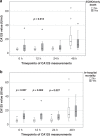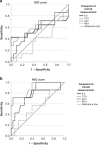CA125: a novel cardiac biomarker for infants with congenital diaphragmatic hernia
- PMID: 35705629
- PMCID: PMC9988682
- DOI: 10.1038/s41390-022-02130-8
CA125: a novel cardiac biomarker for infants with congenital diaphragmatic hernia
Abstract
Background: The carbohydrate antigen 125 (CA125) was proven as a robust biomarker for risk stratification in adults with heart failure. This is the first study analyzing CA125 in a cohort of infants with congenital diaphragmatic hernia (CDH).
Methods: Sixty-eight infants with CDH, treated at the University Children's Hospital Bonn (Germany), between January 2018 and February 2021, were prospectively enrolled for analysis. CA125 values were measured at the following timepoints: 6,12, 24, 48 h, and during ECMO daily from day 1 to day 7.
Results: In infants not surviving to discharge, CA125 values were significantly higher at day 1 (6, 12, and 24 h). Infants with subsequent need for ECMO presented significantly higher CA125 values at 12 h of life. During ECMO, CA125 values measured at day 1 were significantly higher in infants not surviving to discharge. In the ROC analysis, a CA125 value of ≥10 U/ml was calculated as optimal cut-off for the prediction of ECMO and in-hospital mortality. CA125 values correlated significantly with the severity of PH and ventricular dysfunction.
Conclusions: CA125 values correlate significantly with echocardiographic markers of PH and ventricular dysfunction and correlate significantly with parameters of disease severity (need for ECMO, mortality).
Impact: CA125 was proven as robust cardiac biomarker in adult cohorts. Information about the utility as a biomarker in neonatal cohorts is lacking. This is the first study analyzing CA125 as a cardiac biomarker in a cohort of infants with congenital diaphragmatic hernia (CDH). CA125 correlates significantly with markers of echocardiographic assessment (PH and ventricular dysfunction) in infants with CDH and helps to identify infants at high risk for ECMO and in-hospital mortality. The results underline the need for the inclusion of cardiac biomarkers in the clinical routine in neonates at risk for cardiopulmonary failure.
© 2022. The Author(s).
Conflict of interest statement
The authors declare no competing interests.
Figures




References
Publication types
MeSH terms
Substances
LinkOut - more resources
Full Text Sources
Research Materials
Miscellaneous

